The next two regional Canon EXPOs in 2010 will be held in Paris and Tokyo, covering Europe and Asia. Canon's product line is broad, including far more than the photographic technology for which they're best known, including medical imaging and more. The company has also integrated a very large format printer company called Oce, which neatly fills in much of their product line, allowing them to produce a wide array of printed products, offering capabilities that they demonstrated at Canon EXPO 2010.

For all that it was intended as a showcase for Canon's advanced technology and capabilities, Canon was fairly non-specific when it came to details of what was on display, at least concerning the kind of photographic technology we cover. It wasn't hard to read between the lines a little, though, to see at least a few likely near-term products.
Cross Media Station
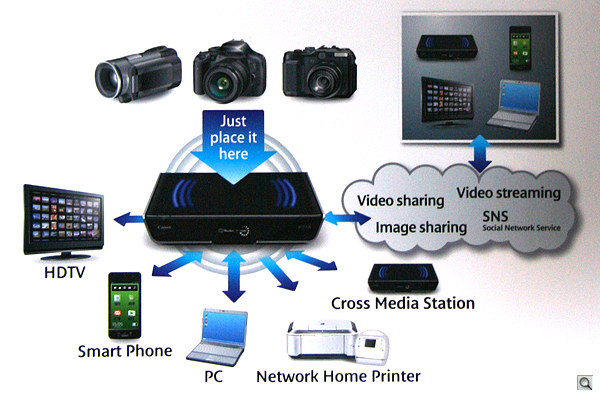
One of Canon's new concepts on display is called Cross Media Station, a tabletop box that is designed to both download images and charge cameras by just placing them on the deck of the Cross Media Station. Images can be uploaded to a server, or sent to another Cross Media Station. According to Canon materials, you can "easily view photographs and video on an HDTV whenever you wish. The Cross Media Station simplifies sharing your precious memories and printing them with ease, and you can quickly locate old photos and video." We were not allowed to photograph the Cross Media Station, as it is just a concept for which "Commercialization has not been determined." The graphic above shows the basic idea, with several cameras sitting on the top of the device. Cameras were current models with plates attached to their bottom that enabled communication and charging, but future products might integrate this connectivity into their design.
Multipurpose Camera
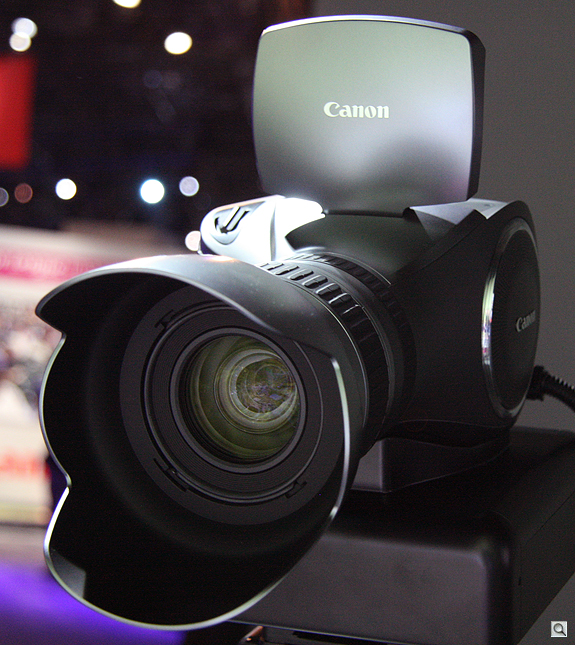
The most complete concept we saw on display was the Multipurpose Camera, which Canon also called a 4K camera. The futuristic design includes an integrated 7-140mm (24-480mm equivalent), 20x optical zoom lens with maximum apertures of f/1.8 to f/3.8. The lens drive system is a new design that is electronically controlled.
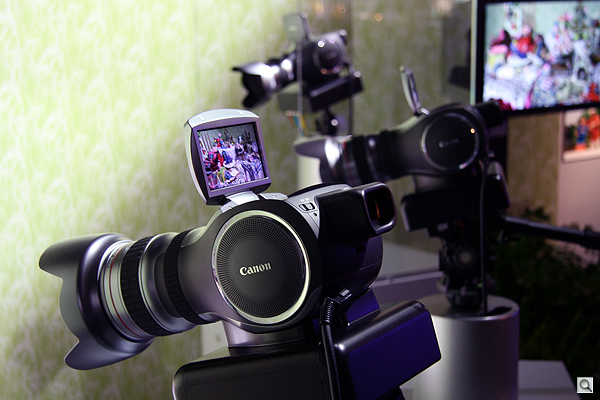
The Canon Multipurpose Camera's 2/3-inch, 8-megapixel CMOS sensor shoots video at more than 60 frames per second at a resolution that's four times greater than HD. That's 4,000 lines of resolution, or 4,096 pixels wide.

With such speed and resolution, you'd be able to draw an 8-megapixel still image from the camera, choosing from more than 60 frames per second. It's hard to see here, but the resolution on the LCD and on the large-screen LCD nearby showed astonishing detail.
Composed of bio-based plastic, the exterior parts of the Canon Multipurpose Camera contain no petroleum-based plastic.
Canon was also separately showing sample video via two REALiS WUX10 Mark II projectors that used blending hardware and software to allow seamless viewing. The final resolution of the blended images in that case was 3,712 x 2,088 pixels.
Multi-Band Camera
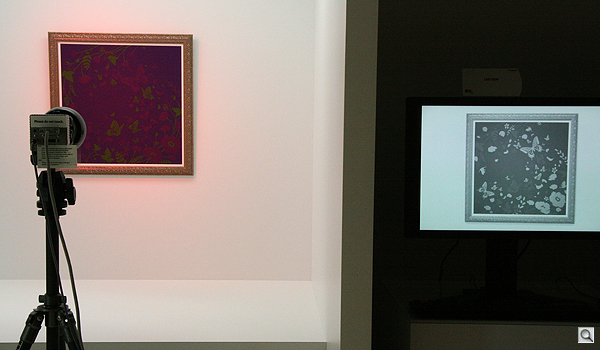
Canon showed what they called the World's First Single-shot Multi-band Camera. Using a 50-million-pixel CMOS sensor, Canon was able to use a six-color filter that they said "enables color distinction that can be realized neither by the human eye nor by RGB (3-color) camera systems.
The new design allows the Multi-band Camera to capture a wider range of colors, and by using multi-point shooting techniques, reflective objects can be reproduced with greater fidelity. Canon showed an example of a butterfly whose wings are reflective only from certain angles. It wasn't clear whether the camera took multiple shots to achieve this effect, or if the camera's multi-band filter allowed it to capture it all at once, but the display showed the original butterfly, then the image captured by the Multi-band Camera, displayed on an iPad screen.
Ultra High-Sensitivity CMOS Sensor Camera
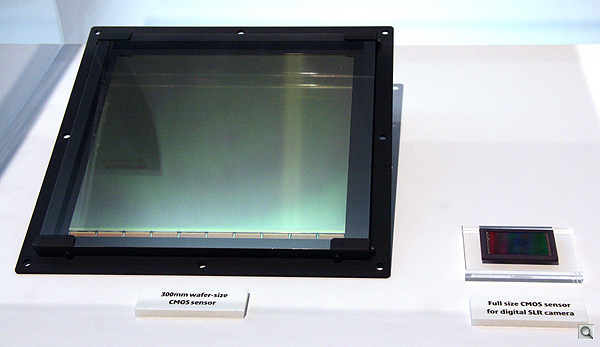
Also of interest was the 300mm wafer-size CMOS sensor with 600um pixels, which is able to capture a 1-megapixel image. Though not terribly high resolution, its extreme sensitivity allows the sensor to capture clear human facial expressions in light measuring only 1 lux, a light level where the naked eye would only see faint movement of shadows, according to Canon. The Ultra High-sensitivity CMOS sensor is currently used in a telescope in Japan.
Ultra High-Resolution Panorama Camera
The Ultra High-Resolution Panorama Camera's 120-megapixel sensor is roughly the size of Canon's current APS-H chip, as used in the EOS-1D Mark IV. This is the maximum size for single-shot exposure by Canon's semiconductor lithography systems, so chips of this size are more efficient to produce. Oddly, while it was billed as an "ultra resolution panorama camera," the sensor looked like it was a standard 3:2 aspect ratio design. Canon was noncommittal about if or when this camera or sensor might appear as a commercial product, but the vibe we picked up was that this might be also appear in the relatively near term. (Whether "near" could mean months or years is an entirely open question.)
Canon also said that the 120-megapixel sensor was comparable to the number of optic nerves in the human eye, which is about 130 million. The sensor can output 1.4 frames per second with a 2.52 Gbps data rate. It can also output Full HD video at 60 fps from a designated area on the sensor.
Canon had several very large touchscreen displays to demonstrate the extremely high resolution of the sensor's output.
Ultra High-Definition 8-Megapixel 30-inch Professional-Use LCD Display
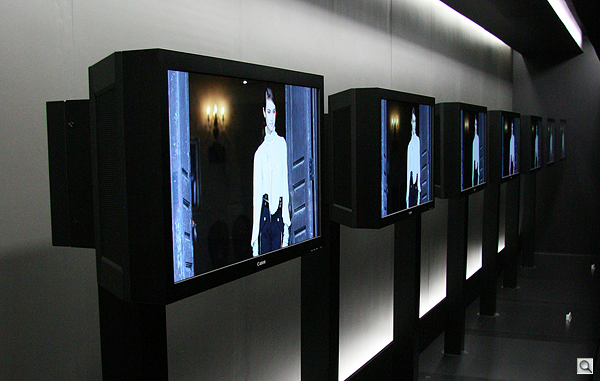
Canon showed prototype LCD monitors with an 8-megapixel display, or roughly 4x HD. The displays were 30 inches, and appeared to be 16:9 ratio. Close examination revealed no visible RGB patterns, and even close-up macro shots were inconclusive.
The Ultra-High-Definition 8-Megapixel displays are designed for use by designers, CGI artists, Printers, Video producers, and in other professional applications.
A shot of the LCD with the Canon logo at the bottom gives an idea of the extremely high resolution of the display, with the highest detail around the subject's eye. Click on the image for the full-resolution shot, which is about 2MB.
Again, here was an area where Canon was unwilling to give a lot of detail on the product, which made us wonder why they were showing it at Canon Expo.
5D Mark II Flythrough
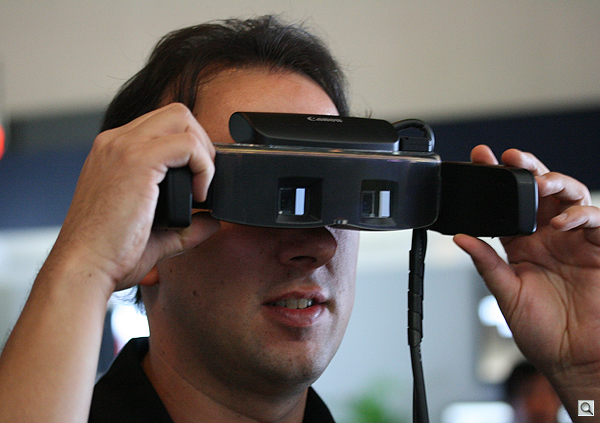
A novelty combined with a 3D technology demonstration allowed visitors to fly into the lens of a Canon 5D Mark II and look around at the mechanical parts. Dan Havlik, Technology Editor at Photo District News, and frequent contributor to Imaging-Resource.com, tries out Canon's 3D glasses. As he watches, a virtual 5D Mark II rises out of the real camera in front of him and begins to approach his view. In seconds he enters the lens and stops in front of the 5D Mark II's large full-frame mirror box.
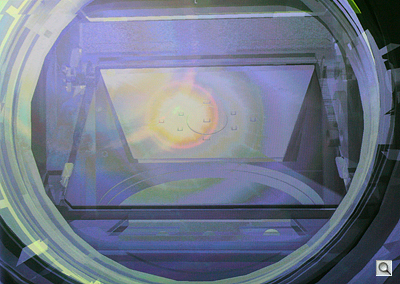 Not much happens beyond that unless you move your head around, something the goggles sense, and respond by showing you translucent representations of the mount and lens body. The demonstration then flips up the mirror and the narrator starts to talk about the 5D Mark II's sensor. It was really standard EXPO fare with very little to learn, but worth the time it took for a brief immersion into the long-touted 3D technology that always seems to be just over the horizon.
Not much happens beyond that unless you move your head around, something the goggles sense, and respond by showing you translucent representations of the mount and lens body. The demonstration then flips up the mirror and the narrator starts to talk about the 5D Mark II's sensor. It was really standard EXPO fare with very little to learn, but worth the time it took for a brief immersion into the long-touted 3D technology that always seems to be just over the horizon.
CR-1 Mark II Digital Retinal Camera
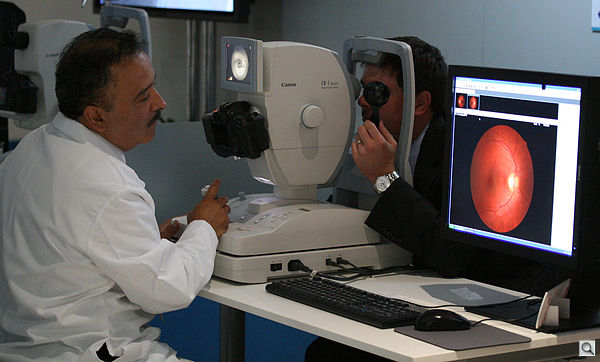
Expo visitors were treated to a free retina scan via Canon's CR-1 Mark II Digital Retinal Cameras, outfitted with what appeared to be Canon 50D bodies.
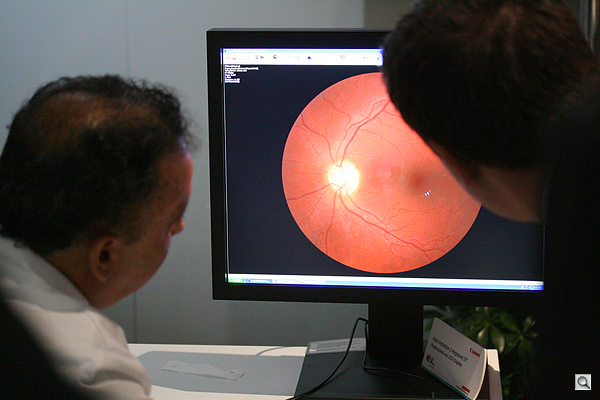
Visitors were then consulted about the resulting images and given a printout. The whole process was painless, took seconds, and didn't involve pupil dilation.
Advanced Image Apparel Company
To show off their newly broadened print capabilities, Canon created a fictitious fashion company, Advanced Image Apparel Company, complete with an art department, business offices, and even book printing capabilities.
Canon staged photoshoots with several of Canon's Explorers of Light photographers, while onlookers to one stage were also able to take shots (not shown) via forty or more cameras on the left and right of the catwalk. Resulting photos were then printed on several large format cameras in the area, and shown on large monitors.
Room-size printers were also put to work printing, binding, and cutting books and brochures made to demonstrate the various printing technologies in Canon's impressive range of products.

A particularly impressive printer on display was the Oce Arizona 550 XT, a Large-Format UV Flatbed Printer. Capable of printing on large, rigid substrates as well as roll paper (as shown above). Rather than printing on a roll and mounting prints to a board, the Oce Arizona 550 XT can print UV ink directly to foamcore boards, outputting more than 22 4 x 8-foot boards per hour.
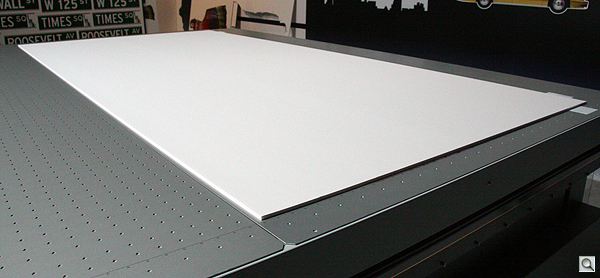
Boards are held in place via suction on the large table, while the massive printhead moves over the substrate.
New Pro Printer
While Canon Expo personnel were pretty coy about mentioning any specific products, they did have a bit to say about a brand-new, high-end professional photo printer, right down to the date it will be announced (January 15, 2011), creating anticipation via a large red LED countdown clock.

They still declined to give us a lot of specifics about the printer, but we did manage to wring a few details from them. The coming product sounds like it will be tailor-made for many professional photographers (and graphic designers, as Canon was quick to point out), who need high-quality photo printing on a regular basis.
The new printer will utilize an all-new ink set, with 12 colors of pigmented ink in new high-capacity ink tanks. This 12-color capability promises to expand the gamut and improve tonality beyond Canon's current Pro 9500 model, which uses 10 pigment-based inks. The new inkset will be delivered to the paper by a new, higher-performance print-head design, which will have a wider nozzle array as well as higher droplet frequencies, to give noticeably faster throughput. (And no, Canon wouldn't characterize the print speeds beyond saying that it'd be faster than the current 9500 model.)
Consistent with Canon's current drive to expand paper compatibility with their current printer models, they claimed that the new model would support a very wide range of third-party papers, with a large library of ICC profiles available right from the initial ship date.
There was a lot of speculation among the press who saw the mysterious black box & countdown timer as to whether the new model would be able to handle 17-inch paper. We didn't have a tape measure with us, but did manage to get a pretty good estimate of the carriage size: The unit in the box pretty clearly had a 13-inch carriage. Whether what we saw will be representative of the final design is unknown.
As you might imagine, Canon didn't give the slightest idea of what the price of the new model might be, but did note that it would represent a new high-end on their Pro printer series, coming in above the current Pro 9000 and Pro 9500, both of which will remain in the lineup.
This looks like a very intriguing printer; likely to come in at a lower price than the bottom end of Canon's current Image ProGraf line, but with higher performance than their current Pixma Pro models; and apparently with higher image quality than any other Canon printer to date. It could indeed fill niches in both professional photographers and in graphic design agencies, where it could crank out very high-quality comps and proofs at relatively low cost.
New Canon Campus

Finally, we grabbed a snapshot of Canon America's planned new headquarters, scheduled to be completed in 2013. The large campus includes multi-level parking and a path for exercising around the facility.
Overall, the show as a good one, with lots of impressive technology to see, but not much of it in our particular area of interest. An entire area was dedicated to futuristic product mockups and new interface possibilities, but the imaginative touch and 3D virtual image-management technology shown was based on technology we've seen in current and future products from other companies. We did appreciate a few of those design concepts, particularly the Navi Cam shown at right.
While it wasn't included in any announced product, a number of the exhibits were based on a 50-megapixel full-frame CMOS sensor chip. Given how often this chip was mentioned, we'd guess that a 50-megapixel full-frame digital SLR can be expected to appear in the not-too-distant future. No mention was made of what the chip's base ISO might be, but we learned that the one on display has a 3.2-micron pixel pitch. That's pretty small for a full-frame sensor, but is actually quite close to the pixel size of Canon's current 18-megapixel subframe chip found in the EOS 7D, T2i, and 60D. It seems reasonable that the ISO capabilities and noise levels of this 50-megapixel sensor would be similar to those current models.
by Dave Etchells and Shawn Barnett; photos by Shawn Barnett